Classification of Partial Discharges Recorded by the Method Using the Phenomenon of Scintillation
Abstract
:1. Introduction
2. Methodology
- the electrical discharge generation system, which consisted of a set of spark gaps, a high-voltage transformer, a voltage divider and a control panel,
- a wireless system for controlling the measurement panel, which consisted of an XBee module and an integrated circuit,
- a system for measuring high-energy radiation, consisting of a scintillation detector based on a scintillation crystal, a photomultiplier and a measurement card.
- type 1: electrodes in oil, blade-to-blade configuration,
- type 2: electrodes in oil with argon bubbles, blade-to-blade configuration,
- type 3: electrodes in oil with air bubbles, blade-to-blade configuration, detector distance 0 mm,
- type 4: electrodes in oil with air bubbles, blade-to-blade configuration, detector distance 80 mm,
- type 5: electrodes in oil with air bubbles, blade-to-blade configuration, detector distance 120 mm.
3. Results and Discussion
4. Conclusions
- the best classifiers for the first group of data turned out to be the linear discriminant analysis algorithm and the SVM support vector machine, for which the accuracy was more than 99%,
- the best classifiers for the second group of data were packed decision trees, for which the accuracy was more than 95%,
- it was possible to achieve high classification efficiency for both data sets, as shown by the values of the measures collected in the tables close to the value of 1.
Author Contributions
Funding
Conflicts of Interest
References
- Haenlein, M.; Kaplan, A. A Brief History of Artificial Intelligence: On the Past, Present, and Future of Artificial Intelligence. Calif. Manag. Rev. 2019, 61, 5–14. [Google Scholar] [CrossRef]
- Panch, T.; Szolovits, P.; Atun, R. Artificial Intelligence, Machine Learning and Health Systems. J. Glob. Health 2018, 8, 020303. [Google Scholar] [CrossRef] [PubMed]
- Haendel, M.A.; Chute, C.G.; Robinson, P.N. Classification, Ontology, and Precision Medicine. N. Engl. J. Med. 2018, 379, 1452–1462. [Google Scholar] [CrossRef] [PubMed]
- Krittanawong, C.; Johnson, K.W.; Rosenson, R.S.; Wang, Z.; Aydar, M.; Baber, U.; Min, J.K.; Wilson Tang, W.H.; Halperin, J.L.; Narayan, S.M. Deep Learning for Cardiovascularmedicine: A Practical Primer. Eur. Heart J. 2019, 40, 2058–2069C. [Google Scholar] [CrossRef] [PubMed]
- Ahmed, Z.; Mohamed, K.; Zeeshan, S.; Dong, X.Q. Artificial Intelligence with Multi-Functional Machine Learning Platform Development for Better Healthcare and Precision Medicine. Database 2020, 2020, baaa010. [Google Scholar] [CrossRef] [PubMed]
- Xie, J.; Li, Y.; Wang, N.; Xin, L.; Fang, Y.; Liu, J. Feature Selection and Syndrome Classification for Rheumatoid Arthritis Patients with Traditional Chinese Medicine Treatment. Eur. J. Integr. Med. 2020, 34, 101059. [Google Scholar] [CrossRef]
- Łysiak, A.; Froń, A.; Bączkowicz, D.; Szmajda, M. Vibroarthrographic Signal Spectral Features in 5-Class Knee Joint Classification. Sensors 2020, 20, 5015. [Google Scholar] [CrossRef] [PubMed]
- Battineni, G.; Chintalapudi, N.; Amenta, F. Machine Learning in Medicine: Performance Calculation of Dementia Prediction by Support Vector Machines (SVM). Inform. Med. Unlocked 2019, 16, 100200. [Google Scholar] [CrossRef]
- Fernandes, J.d.C.V.; de Moura Junior, N.N.; de Seixas, J.M. Deep Learning Models for Passive Sonar Signal Classification of Military Data. Remote Sens. 2022, 14, 2648. [Google Scholar] [CrossRef]
- Dästner, K.; Brunessaux, S.; Schmid, E.; von Haßler Zu Roseneckh-Köhler, B.; Opitz, F. Classification of Military Aircraft in Real-Time Radar Systems Based on Supervised Machine Learning with Labelled ADS-B Data. In 2018 Sensor Data Fusion: Trends, Solutions, Applications (SDF); IEEE: Pitcataway, NJ, USA, 2018. [Google Scholar] [CrossRef]
- Christantonis, K.; Tjortjis, C. Data Mining for Smart Cities: Predicting Electricity by Classification. In Proceedings of the 10th International Conference on Information, Intelligence, Systems and Applications (IISA), Patras, Greece, 15–17 July 2019. [Google Scholar] [CrossRef]
- Wotzka, D.; Cichoń, A. Study on the Influence of Measuring Ae Sensor Type on the Effectiveness of Oltc Defect Classification. Sensors 2020, 20, 3095. [Google Scholar] [CrossRef] [PubMed]
- Kunicki, M.; Wotzka, D. A Classification Method for Select Defects in Power Transformers Based on the Acoustic Signals. Sensors 2019, 19, 5212. [Google Scholar] [CrossRef] [PubMed] [Green Version]
- Wotzka, D.; Sikorski, W.; Szymczak, C. Investigating the Capability of PD-Type Recognition Based on UHF Signals Recorded with Different Antennas Using Supervised Machine Learning. Energies 2022, 15, 3167. [Google Scholar] [CrossRef]
- Jineeth, J.; Mallepally, R.; Sindhu, T.K. Classification of Partial Discharge Sources in XLPE Cables by Artificial Neural Networks and Support Vector Machine. In Proceedings of the 2018 IEEE Electrical Insulation Conference (EIC), San Antonio, TX, USA, 17–20 June 2018; pp. 407–411. [Google Scholar]
- Janani, H.; Shahabi, S.; Kordi, B. Separation and Classification of Concurrent Partial Discharge Signals Using Statistical-Based Feature Analysis. IEEE Trans. Dielectr. And. Electr. Insul. 2020, 27, 1933–1941. [Google Scholar] [CrossRef]
- Zheng, J.; Chen, Z.; Wang, Q.; Qiang, H.; Xu, W. GIS Partial Discharge Pattern Recognition Based on Time-Frequency Features and Improved Convolutional Neural Network. Energies 2022, 15, 7372. [Google Scholar] [CrossRef]
- Nagi, Ł.; Kozioł, M.; Kunicki, M.; Wotzka, D. Using a Scintillation Detector to Detect Partial Discharges. Sensors 2019, 19, 4936. [Google Scholar] [CrossRef] [PubMed]
- Nagi, Ł. Analysis of Ionizing Radiation Generated by Electrical Discharges. Ph.D. Thesis, Opole University of Technology, Opole, Poland, 2016. [Google Scholar]
- Geéron, A. Machine Learning: Using Scikit-Learn and TensorFlow; Helion: Gliwice, Poland, 2018; ISBN 9788328343740. [Google Scholar]
- Confusion Matrix and What It Results In. Available online: https://www.statystyczny.pl/author/admin/ (accessed on 1 July 2022).
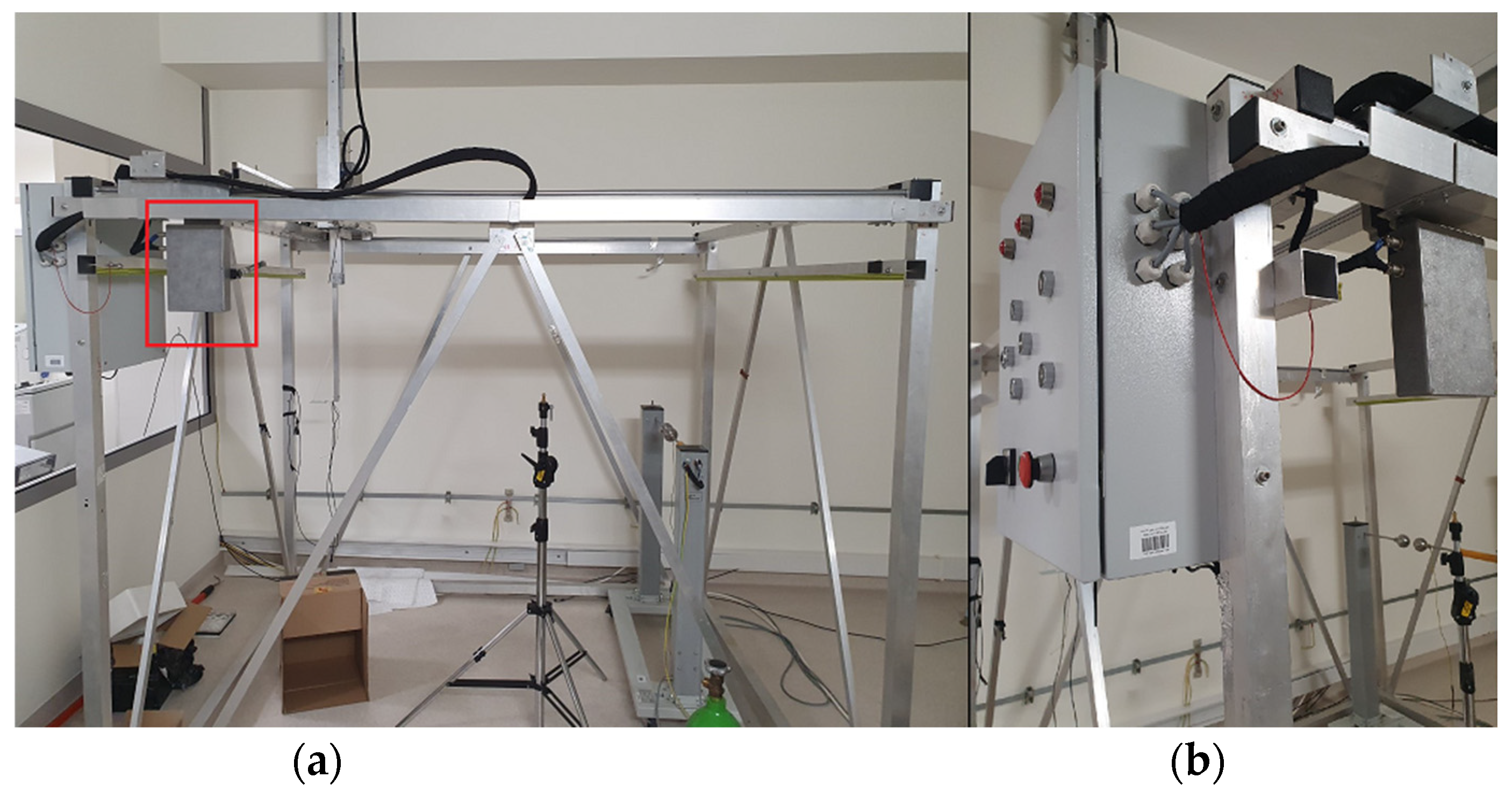

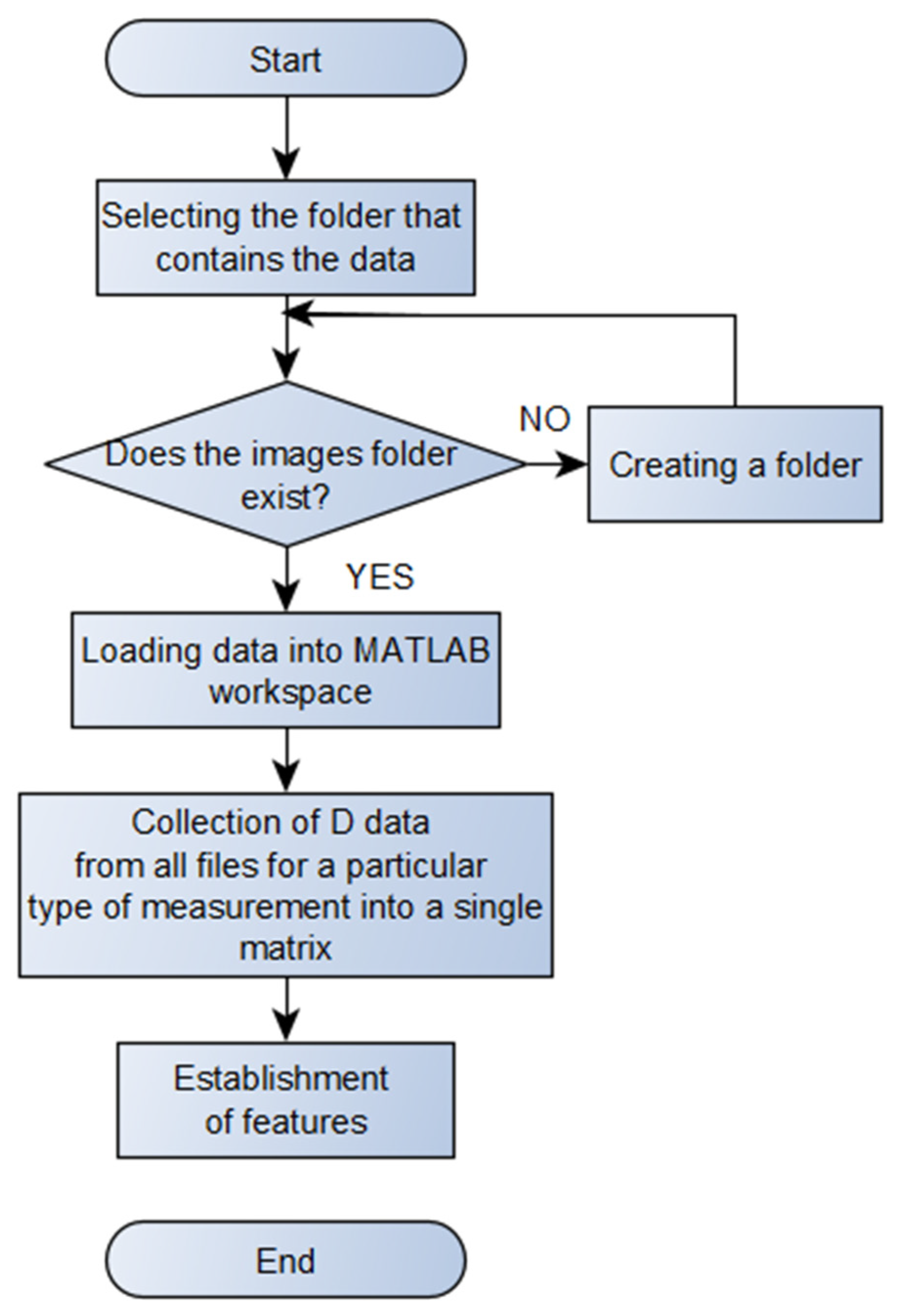
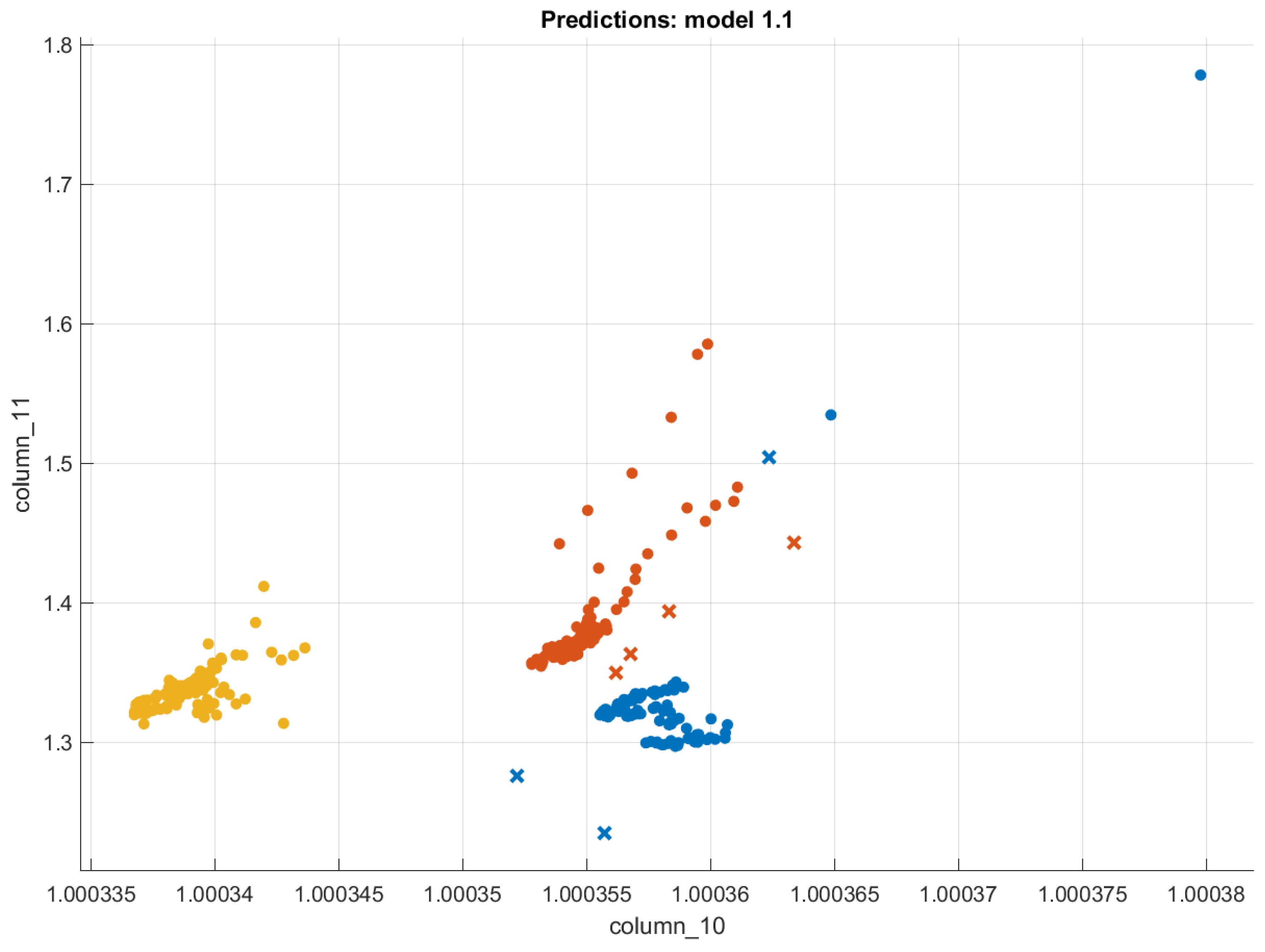
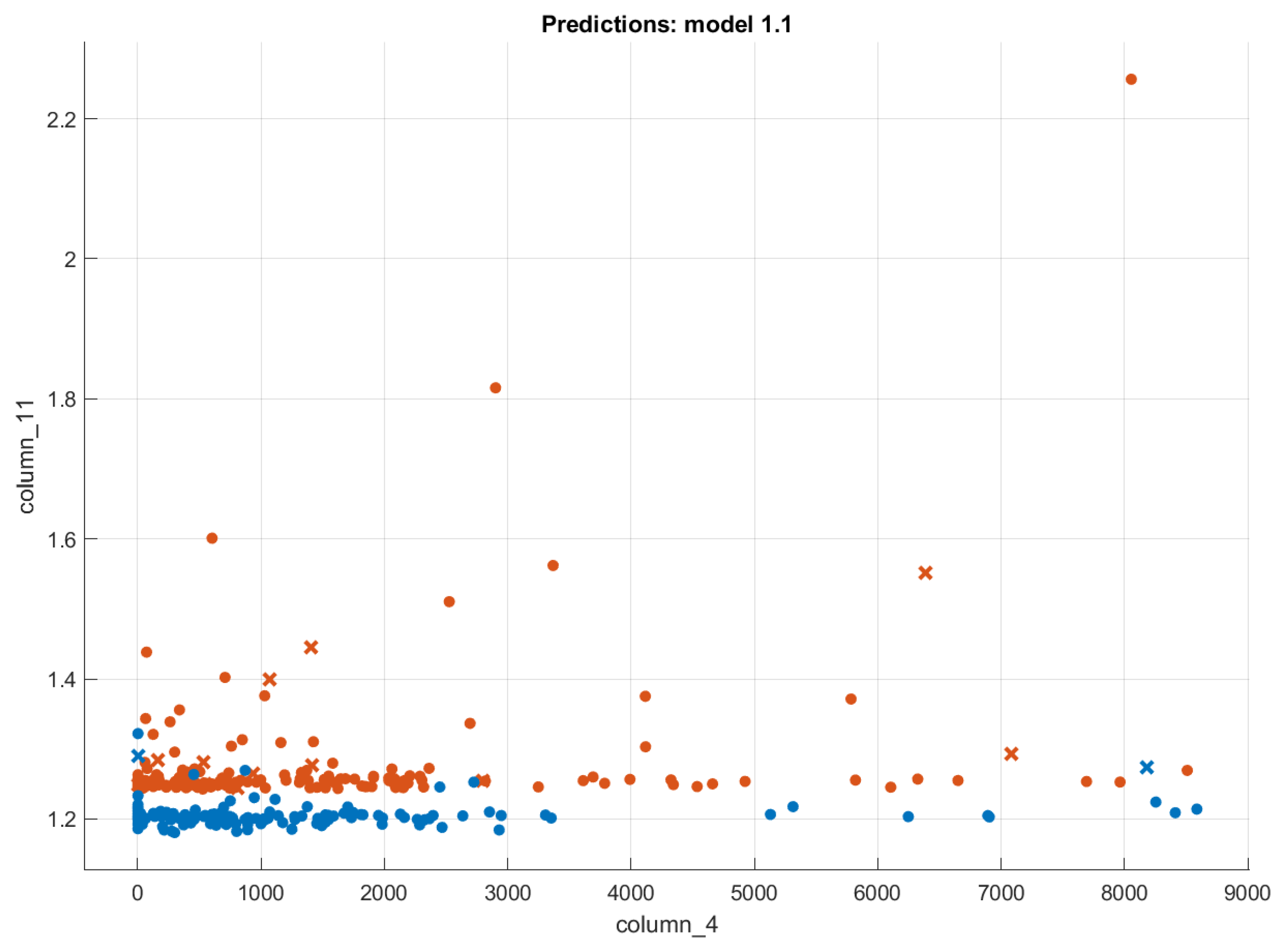

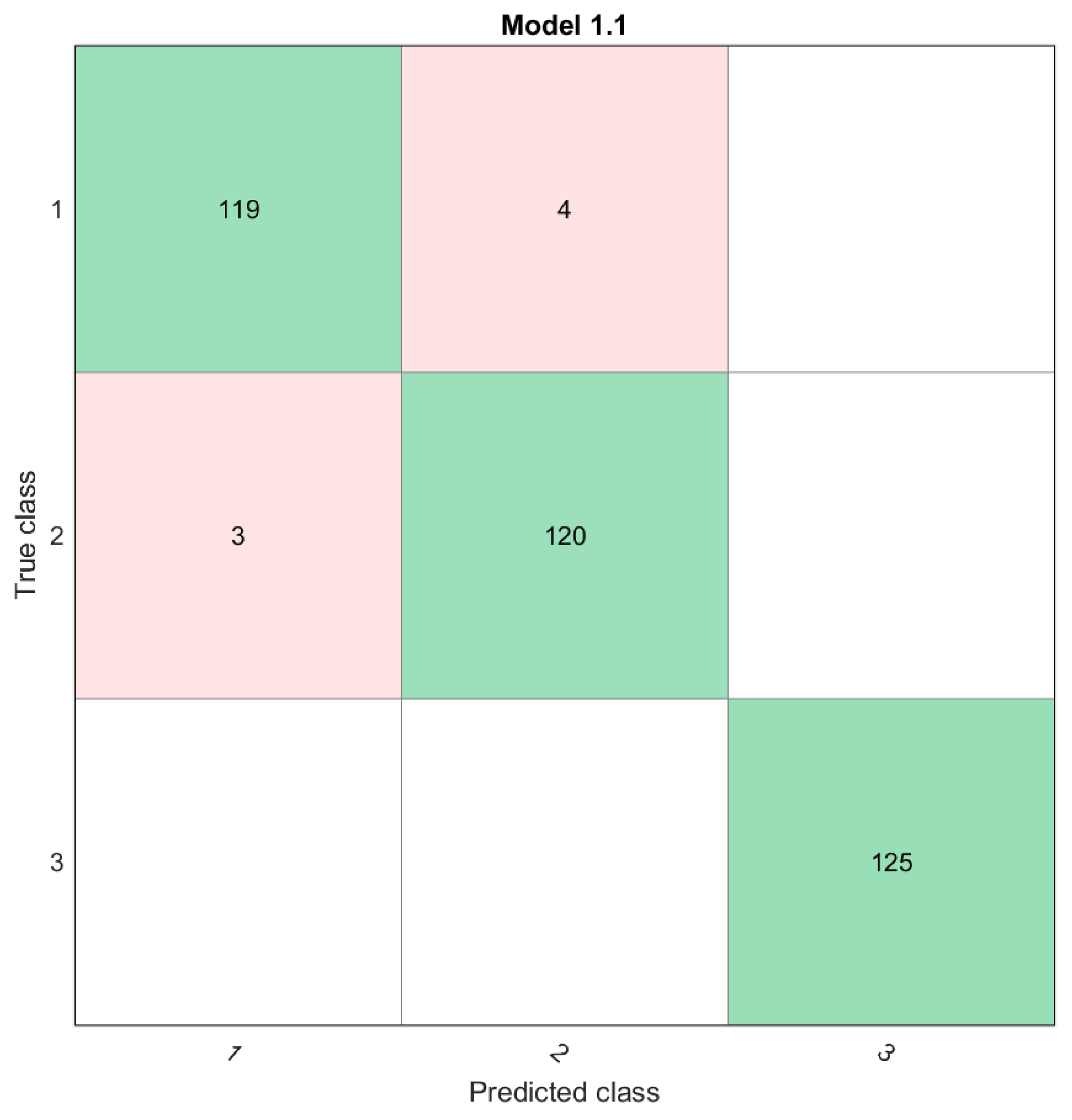
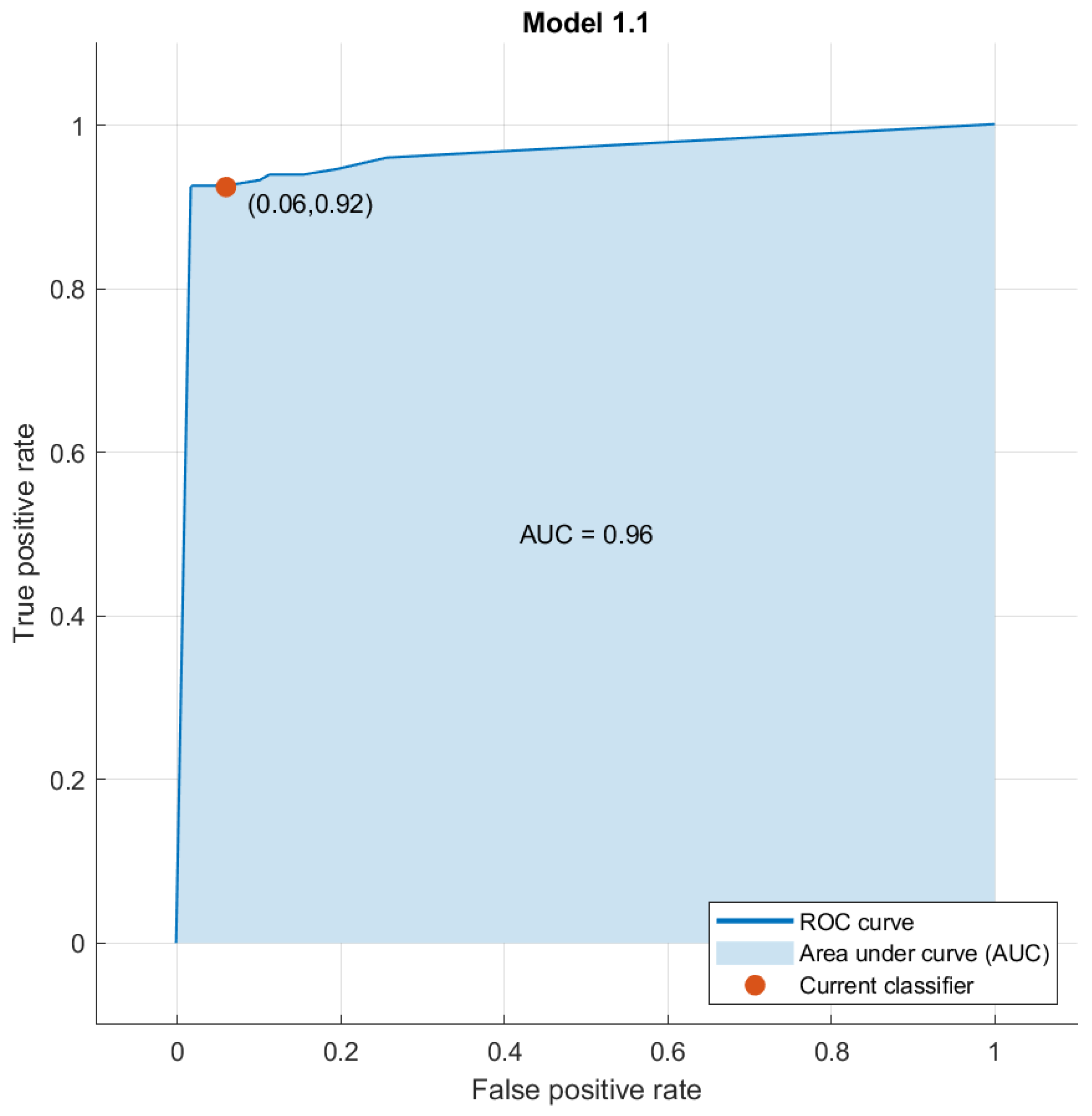
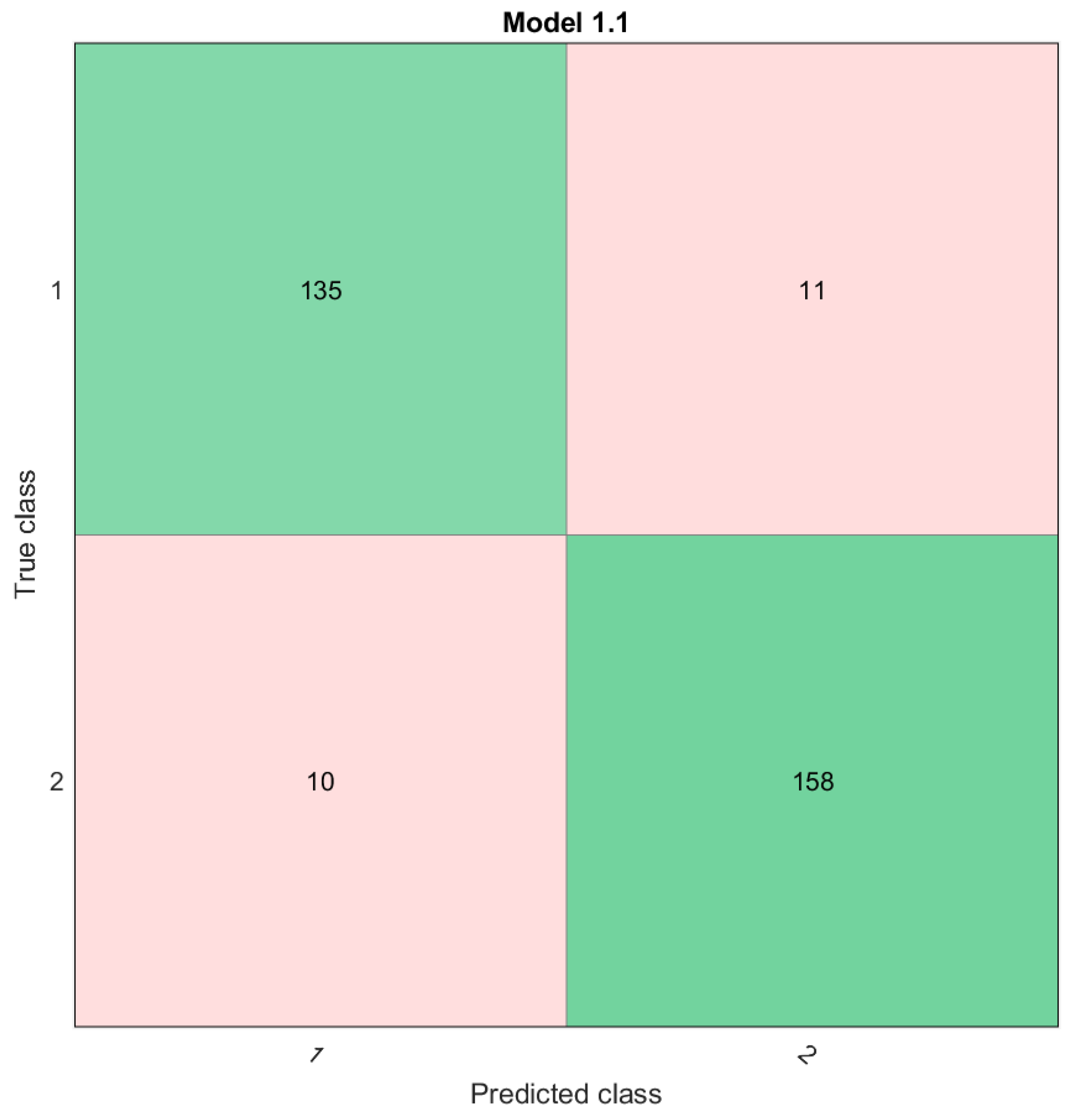
| The Value of the Gamma Parameter | The k Value of Cross-Validation | Sensitivity | Specificity | Precision | Accuracy | F1-Score | Average |
|---|---|---|---|---|---|---|---|
| 0 | 5 | 0.99 | 1.00 | 0.99 | 0.99 | 0.99 | 1.00 |
| 10 | 0.99 | 1.00 | 0.99 | 0.99 | 0.99 | 1.00 | |
| 15 | 0.99 | 1.00 | 0.99 | 0.99 | 0.99 | 1.00 | |
| 0.5 | 5 | 0.99 | 0.99 | 0.99 | 0.99 | 0.99 | 0.99 |
| 10 | 0.99 | 0.99 | 0.99 | 0.99 | 0.99 | 0.99 | |
| 15 | 0.99 | 0.99 | 0.99 | 0.99 | 0.99 | 0.99 | |
| 1 | 5 | 0.98 | 0.99 | 0.98 | 0.98 | 0.98 | 0.98 |
| 10 | 0.96 | 0.98 | 0.96 | 0.96 | 0.96 | 0.97 | |
| 15 | 0.98 | 0.99 | 0.98 | 0.98 | 0.98 | 0.98 |
| The Value of the KernelScale Parameter | The k Value of Cross-Validation | Sensitivity | Specificity | Precision | Accuracy | F1-Score | Average |
|---|---|---|---|---|---|---|---|
| 0 | 5 | 1.00 | 1.00 | 1.00 | 1.00 | 1.00 | 1.00 |
| 10 | 0.99 | 1.00 | 0.99 | 0.99 | 0.99 | 0.99 | |
| 15 | 0.99 | 1.00 | 0.99 | 0.99 | 0.99 | 1.00 | |
| 10 | 5 | 0.96 | 0.98 | 0.96 | 0.96 | 0.96 | 0.96 |
| 10 | 0.96 | 0.98 | 0.96 | 0.96 | 0.96 | 0.97 | |
| 15 | 0.96 | 0.98 | 0.96 | 0.96 | 0.96 | 0.97 | |
| 15 | 5 | 0.33 | 0.67 | 0.66 | 0.34 | 0.34 | 0.47 |
| 10 | 0.33 | 0.67 | 0.67 | 0.34 | 0.34 | 0.47 | |
| 15 | 0.33 | 0.67 | 0.66 | 0.34 | 0.34 | 0.47 |
| NumLearning Cycles Parameter Value | The k Value of Cross-Validation | Sensitivity | Specificity | Precision | Accuracy | F1-Score | Average |
|---|---|---|---|---|---|---|---|
| 30 | 5 | 0.90 | 0.98 | 0.98 | 0.95 | 0.94 | 0.95 |
| 10 | 0.90 | 0.98 | 0.97 | 0.94 | 0.94 | 0.95 | |
| 15 | 0.90 | 0.99 | 0.99 | 0.95 | 0.94 | 0.96 | |
| 50 | 5 | 0.90 | 0.99 | 0.98 | 0.95 | 0.94 | 0.95 |
| 10 | 0.90 | 0.99 | 0.99 | 0.95 | 0.94 | 0.96 | |
| 15 | 0.89 | 0.99 | 0.99 | 0.95 | 0.94 | 0.95 | |
| 100 | 5 | 0.89 | 0.99 | 0.99 | 0.95 | 0.94 | 0.95 |
| 10 | 0.90 | 0.99 | 0.98 | 0.95 | 0.94 | 0.95 | |
| 15 | 0.89 | 0.99 | 0.98 | 0.94 | 0.94 | 0.95 |
Disclaimer/Publisher’s Note: The statements, opinions and data contained in all publications are solely those of the individual author(s) and contributor(s) and not of MDPI and/or the editor(s). MDPI and/or the editor(s) disclaim responsibility for any injury to people or property resulting from any ideas, methods, instructions or products referred to in the content. |
© 2022 by the authors. Licensee MDPI, Basel, Switzerland. This article is an open access article distributed under the terms and conditions of the Creative Commons Attribution (CC BY) license (https://creativecommons.org/licenses/by/4.0/).
Share and Cite
Płużek, A.; Nagi, Ł. Classification of Partial Discharges Recorded by the Method Using the Phenomenon of Scintillation. Energies 2023, 16, 201. https://doi.org/10.3390/en16010201
Płużek A, Nagi Ł. Classification of Partial Discharges Recorded by the Method Using the Phenomenon of Scintillation. Energies. 2023; 16(1):201. https://doi.org/10.3390/en16010201
Chicago/Turabian StylePłużek, Aleksandra, and Łukasz Nagi. 2023. "Classification of Partial Discharges Recorded by the Method Using the Phenomenon of Scintillation" Energies 16, no. 1: 201. https://doi.org/10.3390/en16010201
APA StylePłużek, A., & Nagi, Ł. (2023). Classification of Partial Discharges Recorded by the Method Using the Phenomenon of Scintillation. Energies, 16(1), 201. https://doi.org/10.3390/en16010201







